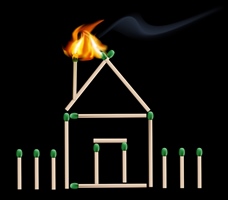According to the Federal Emergency Management Agency (FEMA), more than 2,500 people die and 12,600 are hurt annually in home fires in the United States. The annual cost of property loss from home fires in the U.S. is an estimated $7.3 billion.
These statistics bear out the fact that, on average, a typical American will have one homeowner’s insurance claim every 14 years and one house fire in his or her lifetime. Even a small fire in the kitchen — where most house fires start — can cause major damage and costs.
As a rule of thumb, most of us buy insurance in preparation for the worse-case scenario — a total loss. But having homeowner’s insurance is just the start of earnest fire preparation. First, you need to consider and plan for your family’s safety. Second, examine your homeowner’s policy. And, third, plan for the fact that, while your house is covered, it is often more difficult to obtain compensation for your personal belongings.
Step 1: Have a safety plan
As FEMA explains on its emergency preparation website, Ready.gov, a house fire can become life-threatening in just two minutes, and a residence can be engulfed in flames within five minutes. That’s why it’s critical to have an exit strategy that the whole family knows and can follow in the event of fire.
A good exit plan involves everyone knowing two ways to get out of every room. Also, everyone should know the basics of what to do in the event of fire. Check doorknobs for heat before opening a door; stay low to the ground to avoid smoke; stop, drop, and roll if your clothes catch fire; don’t waste time gathering belongings or valuables; and have a prearranged place to meet up outside. FEMA recommends that families practice the escape plan at least twice a year. If windows are part of the escape plan, check regularly that the windows are easy to open, that screens are easy to remove, and that ladders, if applicable, are accessible and functional.
Be sure to change the batteries on your smoke detectors and alarm regularly. One way to remember this task is to always change the batteries when you set your clocks forward or back for Daylight Savings Time in the spring and fall.
House fires, especially those claiming lives, are always sad but powerful reminders of the dangers of fire. Even if the smoke detectors go off, your house can still be engulfed in flames within minutes, which can potentially cause a tragedy. This makes a strong argument for mandatory sprinkler systems in new homes, which some but not all Maryland counties require. If you are building a new home in a county where they aren’t required, you should insist on sprinklers.
Step 2: Make sure you have the right coverage
All homeowner’s policies will cover fire, and some offer broader coverage than others — but not all policies will cover the replacement cost of your personal belongings such as fine arts, jewelry, silverware, money, oriental rugs, antiques, or other items of rare or historical value. Even if your policy provides coverage for these items, it may have severe limitations. It’s crucial that you clarify with your agent the type of insurance you have. If necessary, make sure you purchase additional coverage.
Step 3: Document your belongings
The best possible way to ensure full compensation for your personal belongings is to prepare a full inventory of everything you own. For most people, this is a daunting task that never seems to make it off the “to-do” list. The next best option is to take video or still pictures of everything in your home, including the contents of your closets, your televisions, computers, shoes you don’t wear, DVDs, old records, and your children’s belongings. Do the same thing with the attic and garage. Open up drawers and take pictures.
Taking pictures does several things. It reminds you of what you lost so you can claim it in the event of a loss. It proves you own the items, so original receipts aren’t necessary. And it helps you prepare a proof of loss statement, an itemized list of everything for which you are claiming payment. Once you have a pictorial inventory, take the time to update it every one to three years. Finally, DO NOT keep your photos or other vital documents at home or in a fireproof safe. Even with a fireproof safe, with a house fire at 1,700 degrees Fahrenheit, everything in the safe will be turned to ashes or destroyed by the heat. Keep your documents off site or at the office.
In my next blog post on this topic, I’ll discuss what to do after a house fire. If you’d like to discuss your personal risk management needs or for more information or help on being prepared, please feel free to contact me at lee@psafinancial.com.




